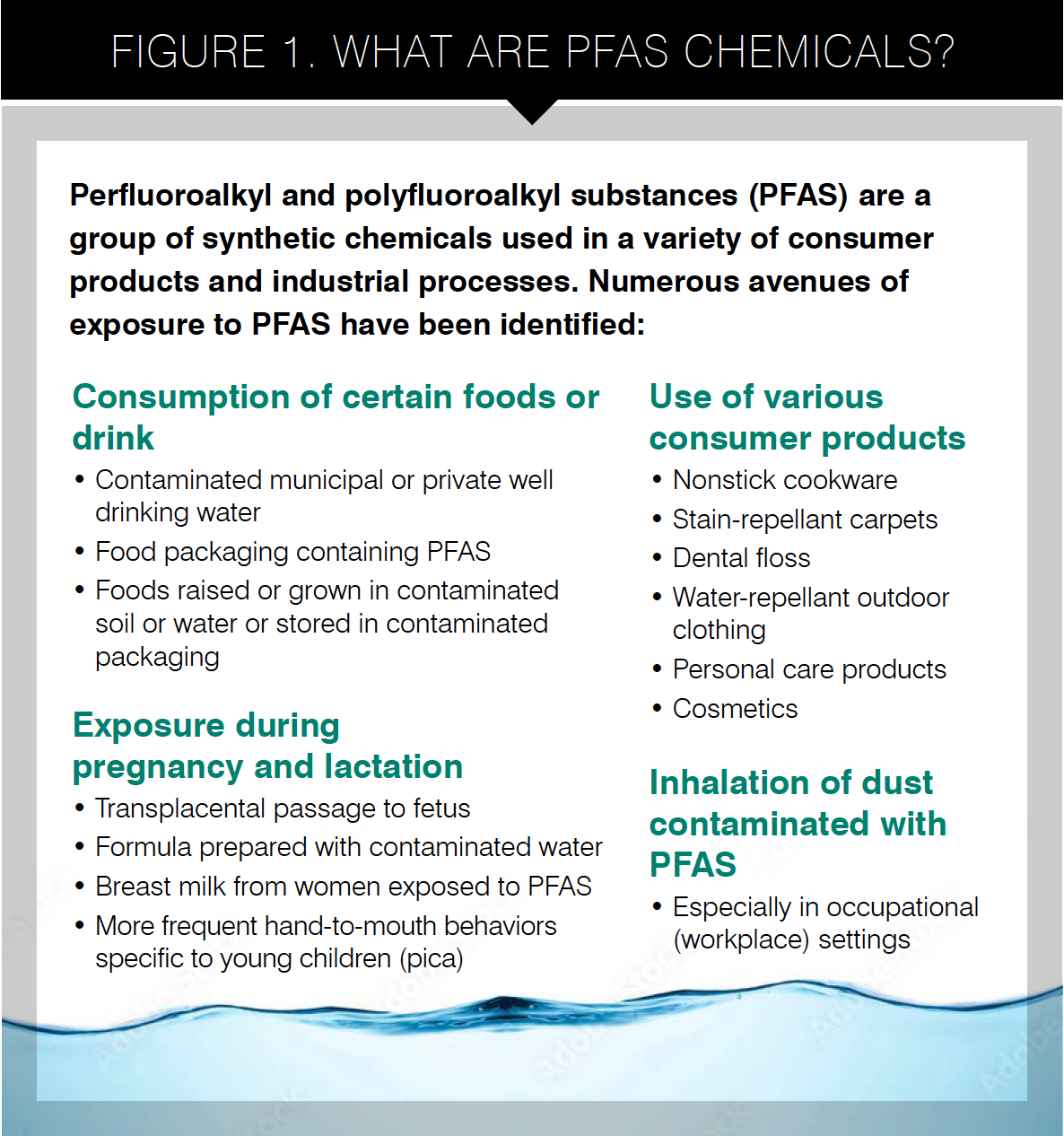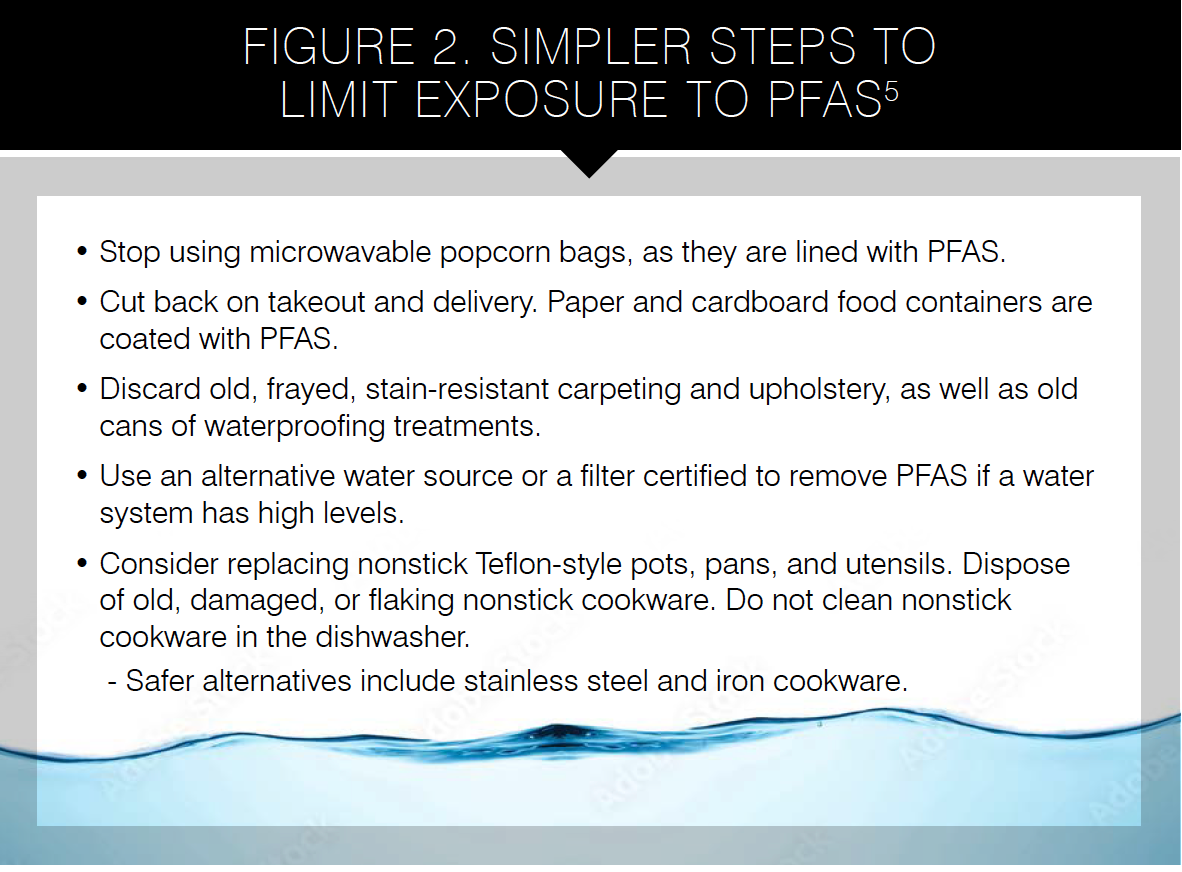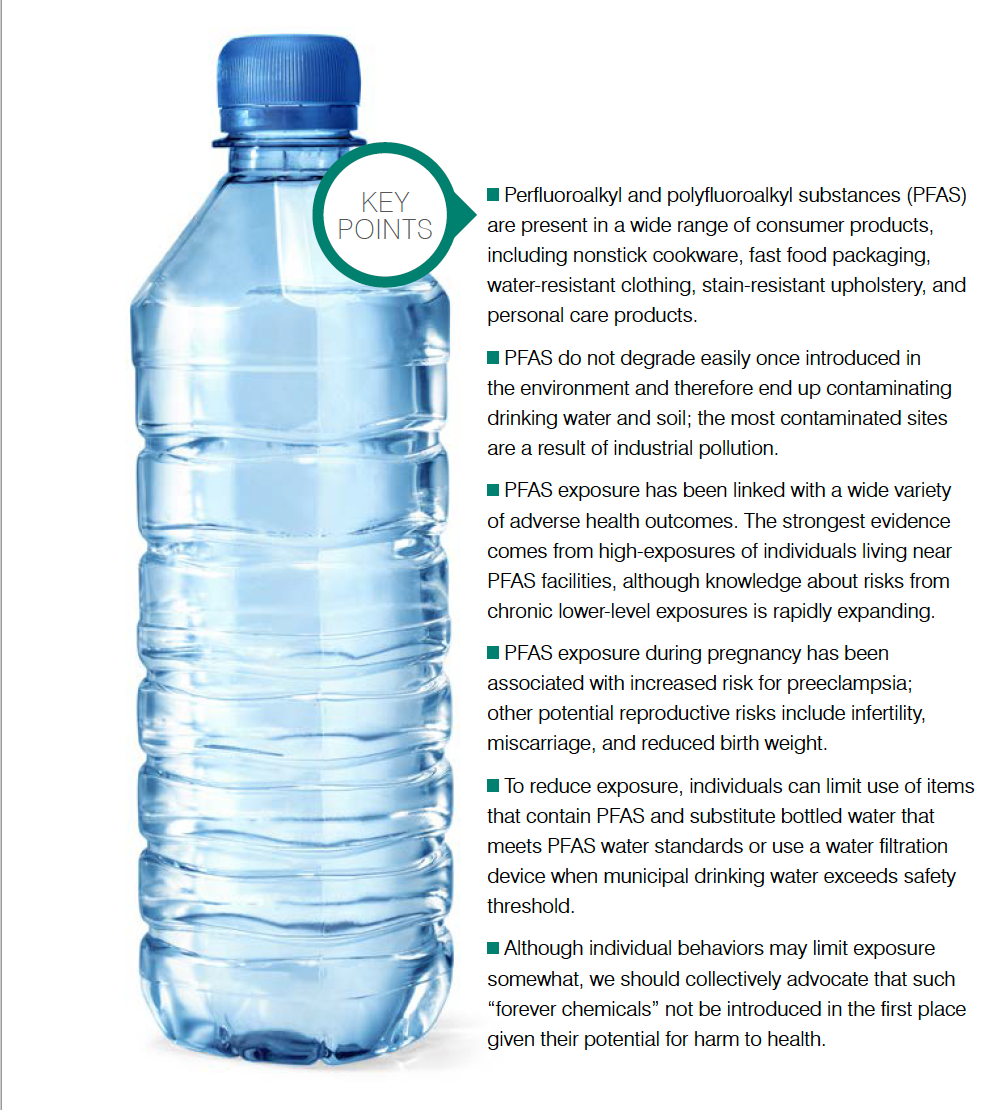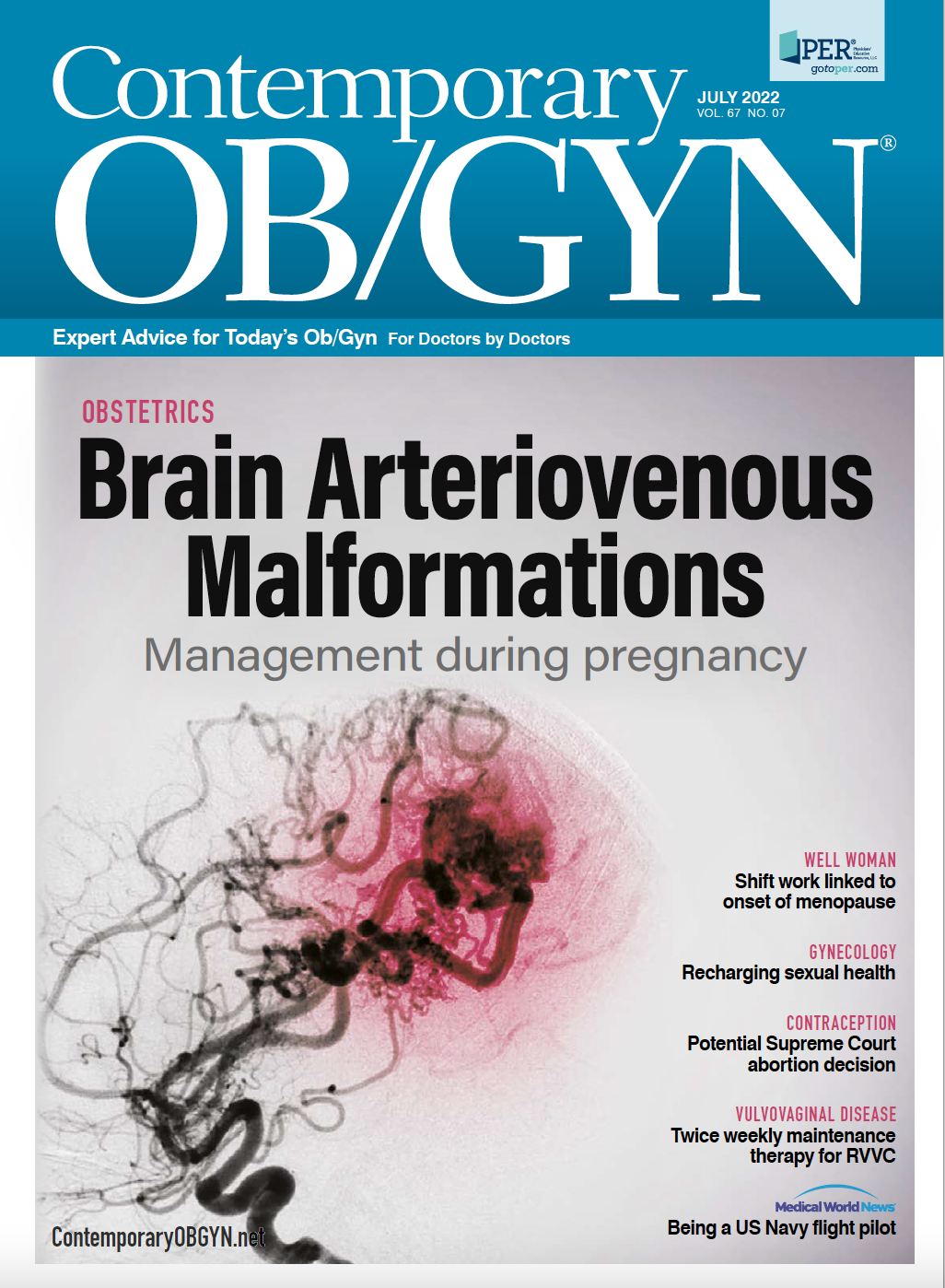Beware of “forever chemicals”
Counsel pregnant and breastfeeding patients about dangers from exposure to PFAS.
“This notice provides important information regarding your drinking water. We are providing this information because our water system exceeded the PFAS (per- and polyfluoroalkyl substances)drinking water standard….This is not an emergency….Consumers in a sensitive group (pregnant or nursing women, infants, immunocompromised) are advised not to consume, drink, or cook with [the town] water…and consult with their physician.”
—Excerpt from a letter written by local municipality to a pregnant patient
“PF-What?” Despite the declaration that this situation was not an emergency, the letter understandably invoked significant anxiety for our patient. When an environmental health risk such as this arises, patients often seek guidance from their clinicians. However, many practicing obstetrician-gynecologists have limited knowledge of and minimal formal education on per- and polyfluoroalkyl substances (PFAS), leaving them ill-equipped to counsel their patients.
What are PFAS? How are we exposed?
PFAS are synthetic chemicals with a strong carbon-fluorine bond, which allows PFAS to resist heat and repel both water and fat (eg, grease or oil). Their remarkable, stain-resistant properties have led to their widespread use in a variety of consumer products for more than 7 decades.1 PFAS are used in nonstick cookware, water- or stain-repellant carpet or fabrics, waterproof clothing, fast-food packaging and wrappers, microwave popcorn bags, pizza boxes, shampoos, nail polish, dental floss, firefighting foam, and more (Figure 1).
FIGURE 1. WHAT ARE PFAS CHEMICALS?

PFAS are quite resistant to degradation and can persist in the environment for years. They contaminate water, air, and soil via manufacturing facilities’ waste, firefighting foam runoff, and leaching from consumer products in landfills.2 The main pathway of exposure for humans is ingestion of contaminated water or food. Once humans are exposed, most PFAS are not extensively metabolized by the body and are excreted slowly through the urine. Some of the older PFAS have biological half-lives of years or even decades. Consequently, PFAS are considered to be “forever chemicals” in both the environment and human bodies.
Given the persistence of PFAS in the environment and the common pathways of exposure, almost everyone has measurable levels of PFAS in their blood.3 Firefighters and individuals who work in occupational settings that manufacture PFAS may be exposed to higher levels than the general population. Infants may be exposed to transplacental exposure during pregnancy or from breast milk. In the United States, serum PFAS concentrations have been declining over the past 2 decades following the voluntary phaseout of 2 long-chain PFAS, perfluorooctanoic acid (PFOA) and perfluorooctanesulfonic acid (PFOS), by US manufacturers.3 Although this downward trend is encouraging, there is growing concern about the widespread industrial use of short-chain PFAS as alternatives to long-chain PFAS because their health risks are not as well known.4
What are potential health concerns from PFAS exposure? What are the risks during pregnancy?
A variety of health outcomes have been raised as potentially resulting from exposure to PFAS (Table5).
Potential human health effects from exposure to PFAS chemicals5

Possible health effects include an increased rate of obesity, elevated cholesterol levels, abnormal liver tests, thyroid dysfunction, increases in testicular and kidney cancers, ulcerative colitis, learning difficulties, attention-deficit/hyperactivity disorder, delayed puberty, and reduced immunologic responses to vaccines. PFAS exposure has been reported to increase the risk of infertility, miscarriage, low birth weight, and preeclampsia. It is important to emphasize that the scientific community’s understanding of how PFAS affects human health is evolving and that no single study can establish causality.
There are limitations in extrapolating effects observed in animal experiments to humans and teasing out potential confounding and coexposures from human cohorts. Nonetheless, the array of potential health outcomes associated with PFAS is worrisome given their persistence in the environment and human bodies.
Some of the most robust evidence regarding the negative health outcomes associated with PFAS exposure is from the C8 Science Panel, which was established as part of a legal settlement between residents of the Ohio River Valley in West Virginia and Ohio and a manufacturer of PFOA that contaminated the air and residents’ local drinking water with millions of pounds of its facility’s waste. PFOA also is known as C8 because of its 8 carbon atoms.
The panel undertook a number of complementary studies from 2005 to 2013 with participation from more than 69,000 adults, including several studies that analyzed birth outcomes.6 The panel concluded that there was a probable link between PFOA exposure and 6 specific health outcomes: increased serum cholesterol levels, ulcerative colitis, thyroid disease, testicular cancer, kidney cancer, and pregnancy-induced hypertension and preeclampsia (hypertensive disorders of pregnancy).7
The C8 panel reviewed results from 4 preeclampsia studies. Even though the studies differed in how and when they measured PFAS exposure during the pregnancy, the panel concluded there was a probable link between PFAS exposure and preeclampsia. In the largest study, results from more than 10,000 individuals found that preeclampsia was 40% more likely in those with measured PFOA levels in the highest quintile of exposure compared with those in the lowest 2 quintiles.8 It is important to emphasize these studies were conducted among a highly exposed population.
Nonetheless, a recent study conducted among a population with exposures more typical of the general population demonstrated an increased odds for late-onset preeclampsia for those exposed to 2 of the longer-chain PFAS, PFOA, and PFOS.9
Among the reproductive health outcomes analyzed—preeclampsia, miscarriage, birth defects, stillbirths, preterm birth, and low birth weight—the C8 panel was only able to confirm an association between PFOA and preeclampsia. That said, research devoted to PFAS exposure in human cohorts, beyond animal toxicology studies, is rapidly increasing. To stay up-to-date, clinicians can access the PFAS-Tox Database online, a “living systematic evidence map” updated frequently with new human, animal, and laboratory studies and organized by health systems.
It will take time to better understand whether other reproductive health outcomes are associated with PFAS exposure, at what levels risk occurs, and whether risks are associated with the shorter-chain PFAS being proposed as alternatives to the older PFOA and PFOS. Although touted as safer alternatives to longer-chain PFAS, emerging evidence suggests shorter-chain PFAS may still be able to disrupt reproductive and endocrine functions.10
How should I counsel my patients about reducing PFAS exposure?
There are ways individuals can reduce exposure to PFAS (Figure 25).
Figure 2. Simpler Steps to Limit Exposure to PFAS5

Old, chipped, or damaged nonstick cookware and bakeware should be discarded and replaced with a safer alternative such as stainless steel or cast iron versions, which do not contain PFAS. If nonstick cookware is used, it is important to keep in mind that PFAS within the nonstick coating can break down at high temperatures and off-gas into the air.
Therefore, patients should cook at low to medium heat and handwash their cookware and bakeware to avoid the high temperatures achieved in the dishwater. Good ventilation also can help to remove any PFAS off-gassing during cooking.
Fast food is often contained in packaging coated with PFAS, including pizza boxes, french fry holders, microwave popcorn bags, and takeout sandwich wrappers. To reduce exposure, patients can limit their fast-food intake or use their own stainless steel or glass containers as substitute takeout containers. Patients can cook popcorn kernels on the stovetop instead of in the microwave. Installing a home water filtration system that is certified to remove PFAS from drinking water is another way to reduce exposure from ingestion. Skin absorbs minimal amounts of PFAS, so no changes to bathing or showering are needed.
Older, frayed carpeting or upholstery should be replaced, particularly in households where children are present as they spend more time on the floor and are more likely to ingest PFAS given their hand-mouth curiosity. Frequent vacuuming and dusting with wet cloths may further decrease PFAS concentrations in the home.
In a study of 37 adults from North Carolina, certain behaviors were associated with changes to measured serum PFAS levels.11 Individuals with more frequent intake of microwaved food had higher PFHxS concentrations while those who vacuumed more often had lower PFHxS concentrations.
Use of a water filtration device led to lower PFOA concentrations, but higher levels of PFHxS. Although the study was small and some of the results were inconsistent, the results suggest that individual behaviors may have an important role in attenuating the risk of exposure to PFAS.
What if my patient is told the drinking water in their town is above health advisory levels?
In 2016, the Environmental Protection Agency established a health advisory level for PFOA and PFOS in drinking water at 70 parts per trillion (ppt) for either PFAS chemical or combined.12 Some states have even stricter guidelines.
For example, in Massachusetts, the drinking water standard is
20 ppt for 6 PFAS chemicals, individually or combined. What is confusing to consumers is that these cutoffs were specified with a margin of protection assuming a lifetime of exposure and therefore do not distinguish between safe versus unsafe drinking water. This is not a “Cinderella moment” where at midnight (70 ppt) water should be considered unsafe, whereas at 11:59 pm (69 ppt) it is safe. That said, there is ongoing debate among scientists, regulators, and environmental advocacy groups about whether these levels provide adequate health protection, especially because they specify only a handful of PFAS chemicals. Chronic exposure, even below levels experienced at contaminated sites or specified by these thresholds, may negatively affect health.
For a pregnant or breastfeeding patient living in an area where the drinking water is found to be above the advisory threshold, it is recommended they use alternatives to the tap water until the water levels are brought back into an acceptable range. Bottled water should be used for drinking, cooking, and brushing teeth—but consumers should be aware that not all bottled water is tested for PFAS.
The United States Food and Drug Administration does not require that bottled water be tested for PFAS. Professional associations, such as the International Bottled Water Association, require members to test annually and maintain levels of less than 10 ppt for 2 or more PFAS, much lower than municipal drinking water standards.
Some states maintain a list of bottled waters that meet the state drinking water standards. Unfortunately, boiling water does not remove PFAS. Water filters can help but need to be specifically designed to remove PFAS. The benefits of breastfeeding outweigh the risks from PFAS exposure. Breast milk concentrations of PFAS chemicals are typically 10% or less of the adult serum concentrations, varying by the specific chemical.13
It is better to switch to alternate drinking sources than to discontinue breastfeeding. If infant nutrition is provided through bottle feeding, alternate water sources should be utilized. Those who are not considered vulnerable (nonpregnant adults) need not alter their drinking water sources.
For patients who receive a notice from their municipality about PFAS, no changes to obstetric clinical care need to be made provided that adequate screening for preeclampsia is occurring at the time of routine prenatal visits. As the ongoing COVID-19 pandemic has interrupted some in-person prenatal care, home blood pressure cuffs should be provided if routine prenatal visits cannot be done in person. Warning signs of preeclampsia should be reviewed.
There is no medication or treatment to administer for PFAS exposure, even if drinking water is above established standards. This is different from acute heavy metal poisoning (eg, acute mercury or lead poisoning), which may require hospitalization and chelation.
Results from testing for levels of PFAS in the blood are not helpful in counseling patients or changing management. Almost everyone in the United States has measurable amounts of PFAS in their blood but the levels do not predict adverse health outcomes, including pregnancy complications such as preeclampsia. Blood levels should be measured only as a part of
research studies.
What other resources are available to learn more about PFAS?
The Agency for Toxic Substances and Disease Registry has published online guidance for health professionals interested in learning more about PFAS.4 Several patient-facing fact sheets are available online and can be printed for sharing with patients.14.15
Key takeaways

Providers also can reach out to their regional Pediatric Environmental Health Specialty Units network to pose a specific environmental health clinical question or ask for additional resources. The units function similar to a poison control center for environmental health concerns, and each maintains a reproductive health specialist in addition to pediatric environmental health experts.
Disclaimer: Wylie has served on the board of the Society for Maternal-Fetal Medicine and is an obstetrics collaborator to the Region 1 Pediatric Environmental Health Specialty Units network. This manuscript was supported by the American Academy of Pediatrics and funded in part by a cooperative agreement with the Centers for Disease Control and Prevention/Agency for Toxic Substances and Disease Registry (CDC/ATSDR). The Environmental Protection Agency (EPA) supports the Pediatric Environmental Health Specialty Units by providing partial funding to CDC/ATSDR through an interagency agreement. The findings and conclusions presented have not been formally disseminated by CDC/ATSDR or EPA and should not be construed to represent any agency determination or policy. Use of trade names that may be mentioned is for identification only and does not imply endorsement by the CDC/ATSDR or EPA.
References
- Kotthoff M, Müller J, Jürling H, Schlummer M, Fiedler D. Perfluoroalkyl and polyfluoroalkyl substances in consumer products. Environ Sci Pollut Res Int. 2015;22(19):14546-14559. doi:10.1007/s11356-015-4202-7
- Sunderland EM, Hu XC, Dassuncao C, Tokranov AK, Wagner CC, Allen JG. A review of the pathways of human exposure to poly- and perfluoroalkyl substances (PFASs) and present understanding of health effects. J Expo Sci Environ Epidemiol. 2019;29(2):131-147. doi:10.1038/s41370-018-0094-1
- National Report on Human Exposure to Environmental Chemicals. Centers for Disease Control and Prevention. Published April 5, 2022. Accessed January 17, 2022. https://www.cdc.gov/exposurereport/
- Bălan SA, Mathrani VC, Guo DF, Algazi AM. Regulating PFAS as a chemical class under the California Safer Consumer Products Program. Environ Health Perspect. 2021;129(2):25001. doi:10.1289/EHP7431
- An overview of the science and guidance for clinicians on per- and polyfluoroalkyl substances (PFAS). Agency for Toxic Substances and Disease Registry. Updated December 6, 2019. Accessed January 17, 2022. https://www.atsdr.cdc.gov/pfas/docs/clinical-guidance-12-20-2019.pdf
- Frisbee SJ, Brooks AP Jr, Maher A, et al. The C8 health project: design, methods, and participants. Environ Health Perspect. 2008;117(12):1873-1882. doi:10.1289/ehp.080037
- C8 probable link reports. C8 Science Panel. Updated October 29, 2012. Accessed January 17, 2022. http://www.c8sciencepanel.org/prob_link.html.
- Savitz DA, Stein CR, Bartell SM, et al. Perfluorooctanoic acid exposure and pregnancy outcome in a highly exposed community. Epidemiology. 2012;23(2):386-392. doi:10.1097/EDE.0b013e31824cb93
- Bommarito PA, Ferguson KK, Meeker JD, McElrath TF, Cantonwine DE. Maternal levels of perfluoroalkyl substances (PFAS) during early pregnancy in relation to preeclampsia subtypes and biomarkers of preeclampsia risk. Env Health Perspect. 2021;129(10):107004. doi:10.1289/EHP9091
- Rickard BP, Rizvi I, Fenton SE. Per- and poly-fluoroalkyl substances (PFAS) and female reproductive outcomes: PFAS elimination, endocrine-mediated effects, and disease. Toxicology. 2022;465:153031. doi:10.1016/j.tox.2021/153031
- Siebenaler R, Cameron R, Butt CM, Hoffman K, Higgins CP, Stapleton HM. Serum perfluoroalkyl acids (PFAAs) and associations with behavioral attributes. Chemosphere. 2017;184:687-693. doi:10.1016/j.chemosphere.2017.06.023
- Drinking water health advisories for PFOA and PFOS. EPA. Accessed January 17, 2022. https://www.epa.gov/ground-water-and-drinking-water/drinking-water-health-advisories-pfoa-and-pfos
- Kärrman A, Ericson I, van Bavel B, et al. Exposure of perfluorinated chemicals through lactation: levels of matched human milk and serum and a temporal trend, 1996-2004, in Sweden. Environ Health Perspect. 2007;115(2):226-230. doi:10.1289/ehp.9491
- How PFAS chemicals affect women, pregnancy, and human development. Health and Environmental Alliance. May 20, 2021. Accessed January 17, 2022. https://www.env-health.org/wp-content/uploads/2021/05/FIGO-PFAS-Fact-Sheet-FINAL-5.20.2021.pdf
- PFAS & health: protecting yourself, your family, and your community from exposure to perfluoroalkyl and polyfluoroalkyl substances. Region 1 New England PEHSU. Accessed January 17, 2022. https://www.childrenshospital.org/sites/default/files/2022-04/pfas-health-factsheet-2022.pdf

Less guideline-concordant care reported among Black breast cancer patients
October 30th 2024In a recent study, non-Hispanic Black patients were less likely to receive guideline-concordant care and had greater mortality rates, highlighting the potential for improved survival by optimizing receipt of timely care.
Read More
Family history criteria used to predict breast cancer genetic risk variants
September 26th 2024In a recent study, patients with a positive response to the Seven-Question Family History Questionnaire were more likely to present with a pathogenic or likely pathogenic variant in the BRCA1 and BRCA2 genes.
Read More
Breast arterial calcifications linked to cardiovascular disease risk
September 12th 2024In a recent study presented at the 2024 Annual Meeting of The Menopause Society, 23% of patients with breast arterial calcifications on a mammogram had atherosclerotic cardiovascular disease, vs 13.9% without.
Read More
